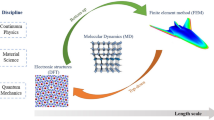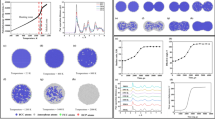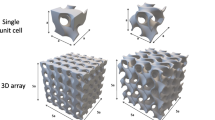Abstract
Laser powder bed fusion (LPBF) is a well-studied additive manufacturing (AM) process that is currently employed in most industries. LPBF manufactured parts tend to be larger, and trial errors are very costly when production fails. Simulation tools enable the anticipation of distortion issues from residual stress formation. These distortions and other defects generated during the LPBF process have thermal origins, and a thorough thermal history simulation is required before any mechanical or metallurgical simulations. The parameters influencing the thermal fields are applied at different spatial and temporal ranges, making it difficult to simulate the entire process with a unique finite element (FE) time-space mesh. The objective of the method presented in this study is to consider every identified parameter with an impact on the thermal field during the process. This approach is a sequential multiscale FE analysis from the macroscale to any specific microscale region. This approach is based on a specific definition of the temporal and spatial domains defined from the mentioned parameters. A case study was performed to highlight the method: progressive zooming was performed to estimate the thermal fields at five different scales, down to the microscale, that is, near a melt pool. Using this approach, specific regions were selected and zoomed down based on the peak temperatures. Simplifying hypotheses were methodically introduced, and both initial and boundary conditions were defined from the results of the previous levels. The computing durations for this specific part were approximately 14 h, and ways of improving the durations were discussed.





















Similar content being viewed by others
Data Availability
The data supporting the findings of this study are available from the corresponding author upon reasonable request.
Code Availability
The code used in Abaqus with specific scripts is not provided (laboratory property).
References
Markl M, Körner C (2016) Multiscale modeling of powder bed-based additive manufacturing. Ann Rev Mater Res 46:93–123
Li C, Fu C, Guo Y, Fang F (2016) A multiscale modeling approach for fast prediction of part distortion in selective laser melting. J Mater Process Technol 229:703–712
Keller N (2016) Nils Keller verfahren durch Multi-Skalen-Simulation Verzugsminimierung bei selektiven Laserschmelzverfahren durch. PhD thesis, Universität Bremen
Meier C, Penny RW, Zou Y, Gibbs JS, Hart AJ (2018) Thermophysical phenomena in metal additive manufacturing by selective laser melting: fundamentals, modeling, simulation, and experimentation. Ann Rev Heat Transfer 20(1):241–316
Hashemi SM, Parvizi S, Baghbanijavid H, Tan AT, Nematollahi M, Ramazani A, Fang NX, Elahinia M (2022) Computational modelling of process-structure-property-performance relationships in metal additive manufacturing: A review. Int Mater Rev 67(1):1–46
Mercelis P, Kruth JP (2006) Residual stresses in selective laser sintering and selective laser melting. Rapid Prototyping Journal 12(5):254–265
Rubenchik AM, King WE, Wu SS (2018) Scaling laws for the additive manufacturing. J Mater Process Technol 257(February):234–243
Leung CLA, Marussi S, Atwood RC, Towrie M, Withers PJ, Lee PD (2018) In situ X-ray imaging of defect and molten pool dynamics in laser additive manufacturing. Nat Commun 9(1):1–9
Parry L, Ashcroft IA, Wildman RD (2016) Understanding the effect of laser scan strategy on residual stress in selective laser melting through thermo-mechanical simulation. Additive Manufact 12:1–15
Ali H, Ghadbeigi H, Mumtaz K (2018) Effect of scanning strategies on residual stress and mechanical properties of Selective Laser Melted Ti6Al4V. Mater Sci Eng A 712:175–187 no. November 2017
Liu Y, Yang Y, Wang D (2016) A study on the residual stress during selective laser melting (SLM) of metallic powder. Int J Adv Manuf Technol 87(1–4):647–656
Stef J (2018) Fusion Laser Selective de poudres de TA6V : microstructure et mécanismes de formation des porosités en lien avec les paramètres du procédé SLM et les propriétés structurales. PhD thesis
Khairallah SA, Martin AA, Lee JRI, Guss G, Calta NP, Hammons JA, Nielsen MH, Chaput K, Schwalbach E, Shah MN, Chapman MG, Willey TM, Rubenchik AM, Anderson AT, Wang YM, Matthews MJ, King WE (2020) Controlling interdependent meso-nanosecond dynamics and defect generation in metal 3D printing. Science 368(6491):660–665
Hooper PA (2018) Melt pool temperature and cooling rates in laser powder bed fusion. Additive Manuf 22(May):548–559
Mitchell JA, Ivanoff TA, Dagel D, Madison JD, Jared B (2020) Linking pyrometry to porosity in additively manufactured metals. Additive Manuf 31:100946
Teng C, Pal D, Gong H, Zeng K, Briggs K, Patil N, Stucker B (2017) A review of defect modeling in laser material processing. Additive Manuf 14:137–147
Cole KD, Beck JV, Haji-Sheikh A, Litkouhi B (1992) Heat conduction using Green’s functions. Taylor & Francis Group, second edi ed
Yang Y, Keulen FV, Ayas C (2020) A computationally efficient thermal model for selective laser melting. . Additive Manuf 31(November 2019):100955
Moran T, Warner D, Phan N (2021) Scan-by-scan part-scale thermal modelling for defect prediction in metal additive manufacturing. Additive Manuf 37:101667
Reza Yavari M, Cole KD, Rao P (2019) Thermal modeling in metal additive manufacturing using graph theory. J Manuf Sci Eng Trans ASME 141(7):1–20
Yavari R, Williams R, Cole K, Hooper P, Rao P (2020) Thermal modeling in metal additive manufacturing using graph theory: experimental validation with in-situ infrared thermography data from laser powder bed fusion. J Manuf Sci Eng 142(December):1–43
Ganeriwala R, Strantza M, King W, Clausen B, Phan T, Levine L, Brown D, Hodge N (2019) Evaluation of a thermomechanical model for prediction of residual stress during laser powder bed fusion of Ti-6Al-4V. Additive Manufacturing 27:489–502
Zaeh MF, Branner G (2010) Investigations on residual stresses and deformations in selective laser melting. Production Engineering 4(1):35–45
Williams RJ, Davies CM, Hooper PA (2018) A pragmatic part scale model for residual stress and distortion prediction in powder bed fusion. Additive Manuf 22(March):416–425
Desmaison O, Pires PA, Levesque G, Peralta A, Sundarraj S, Makinde A, Jagdale V, Megahed M (2017) Influence of computational grid and deposit volume on residual stress and distortion prediction accuracy for additive manufacturing modeling. In: Proceedings of the 4th world congress on integrated computational materials engineering (ICME 2017), vol Part F4, pp 365–374, The Minerals, Metals & Materials Series
Setien I, Chiumenti M, van der Veen S, San Sebastian M, Garciandía F, Echeverría A (2019) Empirical methodology to determine inherent strains in additive manufacturing. Comput Math Applic 78(7):2282–2295
Carraturo M, Viguerie A, Reali A, Auricchio F (2022) Two-level method part-scale thermal analysis of laser powder bed fusion additive manufacturing. Eng Comput, pp 1–14
Wei LC, Ehrlich LE, Powell-Palm MJ, Montgomery C, Beuth J (2018) Malen JA (2018) Thermal conductivity of metal powders for powder bed additive manufacturing. Additive Manuf 21(December 2017):201–208
Alkahari MR, Furumoto T, Ueda T, Hosokawa A, Tanaka R, Abdul Aziz MS (2012) Thermal conductivity of metal powder and consolidated material fabricated via selective laser melting. Key Eng Mater 523–524:244–249
Denlinger ER, Jagdale V, Srinivasan GV, El-Wardany T, Michaleris P (2016) Thermal modeling of Inconel 718 processed with powder bed fusion and experimental validation using in situ measurements. Additive Manuf 11:7–15
Li C, Gouge MF, Denlinger ER, Irwin JE, Michaleris P (2019) Estimation of part-to-powder heat losses as surface convection in laser powder bed fusion. Additive Manuf 26(January):258–269
Dugast F, Apostolou P, Fernandez A, Dong W, Chen Q, Strayer S, Wicker R, To AC (2021) Part-scale thermal process modeling for laser powder bed fusion with matrix-free method and GPU computing. Additive Manuf 37:101732
Zhang W, Tong M, Harrison NM (2019) Resolution, energy and time dependency on layer scaling in finite element modelling of laser beam powder bed fusion additive manufacturing. Addit Manuf 28:610–620 no. November 2018
Lindwall J, Malmelöv A, Lundbäck A, Lindgren LE (2018) Efficiency and accuracy in thermal simulation of powder bed fusion of bulk metallic glass. Jom 70(8):1598–1603
Luo Z, Zhao Y (2018) A survey of finite element analysis of temperature and thermal stress fields in powder bed fusion Additive Manufacturing. Additive Manuf 21(March 2017):318–332, 2018
Chen Q, Liang X, Hayduke D, Liu J, Cheng L, Oskin J, Whitmore R , To AC (2019) An inherent strain based multiscale modeling framework for simulating part-scale residual deformation for direct metal laser sintering. Addit Manuf 28:406–418 no. December 2018
Foroozmehr A, Badrossamay M, Foroozmehr E, Golabi S (2016) Finite element simulation of selective laser melting process considering optical penetration depth of laser in powder bed. Mater Design 89:255–263
Tran HC, Lo YL (2018) Heat transfer simulations of selective laser melting process based on volumetric heat source with powder size consideration. J Mater Process Technol 255:411–425 no. December 2017
Luo Z, Zhao Y (2019) Numerical simulation of part-level temperature fields during selective laser melting of stainless steel 316L. Int J Adv Manuf Technol 104(5–8):1615–1635
Luo Z, Zhao Y (2020) Efficient thermal finite element modeling of selective laser melting of Inconel 718. Comput Mech 65(3):763–787
Keller N, Ploshikhin V (2014) New method for fast predictions of residual stress and distortion of AM parts. In: Solid freefrom fabrication, pp 1689–1699
Tran HT, Chen Q, Mohan J, To AC (2020) A new method for predicting cracking at the interface between solid and lattice support during laser powder bed fusion additive manufacturing. Additive Manuf 32(January):101050
Bayat M, Dong W, Thorborg J, To AC, Hattel JH (2021) A review of multi-scale and multi-physics simulations of metal additive manufacturing processes with focus on modeling strategies. Additive Manuf 47(March):102278
Paudel BJ, Thompson SM (2019) Localized effect of overhangs on heat transfer during laser powder bed fusion additive manufacturing. In: Solid freeform fabrication 2019: Proceedings of the 30th annual international solid freeform fabrication symposium – an additive manufacturing conference
Keller N, Neugebauer F, Xu H, Ploshikhin V (2013) Thermo-mechanical simulation of additive layer manufacturing of titanium aerospace structures. In: LightMAT conference, vol 3, no 5
Li C, Liu JF, Fang XY, Guo YB (2017) Efficient predictive model of part distortion and residual stress in selective laser melting. Additive Manuf 17:157–168
Li C, Liu ZY, Fang XY, Guo YB (2018) On the simulation scalability of predicting residual stress and distortion in selective laser melting. J Manuf Sci Eng 140(4):041013
Williams RJ, Piglione A, Rønneberg T, Jones C, Pham MS, Davies CM, Hooper PA (2019) In situ thermography for laser powder bed fusion: Effects of layer temperature on porosity, microstructure and mechanical properties. Additive Manufacturing 30(March)100880
Denlinger ER, Heigel JC, Michaleris P, Palmer TA (2015) Effect of inter-layer dwell time on distortion and residual stress in additive manufacturing of titanium and nickel alloys. J Mater Process Technol 215:123–131
Wolff SJ, Lin S, Faierson EJ, Liu WK, Wagner GJ, Cao J (2017) A framework to link localized cooling and properties of directed energy deposition (DED)-processed Ti-6Al-4V. Acta Materialia 132:106–117
Mirkoohi E, Seivers DE, Garmestani H, Liang SY (2019) Heat source modeling in selective laser melting. Materials 12(13):1–18
Hocine S, Van Swygenhoven H, Van Petegem S (2021) Verification of selective laser melting heat source models with operando X-ray diffraction data. Additive Manuf 37:101747
Yang Y, Zhou X (2020) A volumetric heat source model for thermal modeling of additive manufacturing of metals. Metals 10:1406
Dilip JJ, Zhang S, Teng C, Zeng K, Robinson C, Pal D, Stucker B (2017) Influence of processing parameters on the evolution of melt pool, porosity, and microstructures in Ti-6Al-4V alloy parts fabricated by selective laser melting. Progress in Additive Manuf 2(3):157–167
Le TN, Lo YL, Tran HC (2019) Multi-scale modeling of selective electron beam melting of Ti6Al4V titanium alloy. Int J Adv Manuf Technol 105(1–4):545–563
Khairallah SA, Anderson AT, Rubenchik A, King WE (2016) Laser powder-bed fusion additive manufacturing: Physics of complex melt flow and formation mechanisms of pores, spatter, and denudation zones. Acta Materialia 108:36–45
Funding
Partial financial support was received from the Halbronn Company (salary of the PhD, CIFRE, and financial contract with the laboratory, with funding from the French funding agency ANRT).
Author information
Authors and Affiliations
Contributions
Y. Bresson: Software, Methodology, Writing (Original draft preparation). A. Tongne: Methodology, Writing (Reviewing and Editing). M. Baili: Methodology, Writing (Reviewing and Editing). L. Arnaud: Supervision, Methodology, Writing (Reviewing and Editing).
Corresponding author
Ethics declarations
Conflicts of interest
The authors have no conflicts of interest relevant to the content of this article to declare.
Additional information
Publisher's Note
Springer Nature remains neutral with regard to jurisdictional claims in published maps and institutional affiliations.
Rights and permissions
Springer Nature or its licensor (e.g. a society or other partner) holds exclusive rights to this article under a publishing agreement with the author(s) or other rightsholder(s); author self-archiving of the accepted manuscript version of this article is solely governed by the terms of such publishing agreement and applicable law.
About this article
Cite this article
Bresson, Y., Tongne, A., Baili, M. et al. Global-to-local simulation of the thermal history in the laser powder bed fusion process based on a multiscale finite element approach. Int J Adv Manuf Technol 127, 4727–4744 (2023). https://doi.org/10.1007/s00170-023-11427-9
Received:
Accepted:
Published:
Issue Date:
DOI: https://doi.org/10.1007/s00170-023-11427-9




